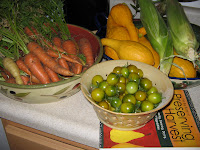 Much of the property was devoted to an orchard and endless rows of corn, onions, berries, squash, asparagus, garlic, beans, peas, etc. My father grew everything possible in our NW climate and my mother did everything she could to preserve it through the winter months. Our cellar in the basement was filled to the brim by late September with canned peaches, pears, applesauce, cherries, stewed tomatoes, and so on. It’s no wonder that when I bring up the subject of canning with my mom today, she lets out a huge sigh and says “Oh, canning… ugh, it’s so much work…”
Much of the property was devoted to an orchard and endless rows of corn, onions, berries, squash, asparagus, garlic, beans, peas, etc. My father grew everything possible in our NW climate and my mother did everything she could to preserve it through the winter months. Our cellar in the basement was filled to the brim by late September with canned peaches, pears, applesauce, cherries, stewed tomatoes, and so on. It’s no wonder that when I bring up the subject of canning with my mom today, she lets out a huge sigh and says “Oh, canning… ugh, it’s so much work…”
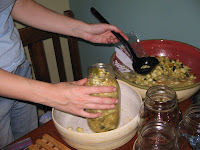 My sister and I had great examples of tending a small plot of city land and making it stretch through the cold season. Now that we each have our own meager plots of land, we’ve reached a point of no more excuses. If we’re serious about this whole sustainability/living off the urban land thing, it’s time we figured out how to can the goods. Although the headlight on our car is still not replaced, I did manage to muster up enough motivation to have a canning day with Anne recently. With Blondie playing in the background and “magical” scarves wrapped around our heads (compliments of my 7 year old nephew), we managed to crank out canned zucchini salsa, sweetened watermelon rinds, pesto, and honey-vinegar carrots.
My sister and I had great examples of tending a small plot of city land and making it stretch through the cold season. Now that we each have our own meager plots of land, we’ve reached a point of no more excuses. If we’re serious about this whole sustainability/living off the urban land thing, it’s time we figured out how to can the goods. Although the headlight on our car is still not replaced, I did manage to muster up enough motivation to have a canning day with Anne recently. With Blondie playing in the background and “magical” scarves wrapped around our heads (compliments of my 7 year old nephew), we managed to crank out canned zucchini salsa, sweetened watermelon rinds, pesto, and honey-vinegar carrots.
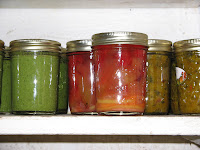 I have to imagine canning alone is a big bore, so I highly recommend roping someone in to help out. The time passes much faster when you can talk celebrity gossip over mounds of chopped tomatoes. It also proved to be a great bridge to the past with my mom and grandmother. I had to call each of them a couple times throughout the day to discuss different matters: the on-going debate among canners on whether a hot-water bath is always necessary, are scallions the same thing as green onions, what’s the difference between Kosher salt and pickling salt, etc. Although my mom has no interest in taking up canning again, I could tell she enjoyed passing along her wisdom and watching her girls grow into their own little urban homesteaders. My grandmother is a direct descendant of pioneers from the Oregon Trail, and she loves anything having to do with homesteading. It’s probably a relief to her that the value of learning those self-sufficiency skills still has a place in our modern world.
I have to imagine canning alone is a big bore, so I highly recommend roping someone in to help out. The time passes much faster when you can talk celebrity gossip over mounds of chopped tomatoes. It also proved to be a great bridge to the past with my mom and grandmother. I had to call each of them a couple times throughout the day to discuss different matters: the on-going debate among canners on whether a hot-water bath is always necessary, are scallions the same thing as green onions, what’s the difference between Kosher salt and pickling salt, etc. Although my mom has no interest in taking up canning again, I could tell she enjoyed passing along her wisdom and watching her girls grow into their own little urban homesteaders. My grandmother is a direct descendant of pioneers from the Oregon Trail, and she loves anything having to do with homesteading. It’s probably a relief to her that the value of learning those self-sufficiency skills still has a place in our modern world.
We won’t know how most of our creations turned out for a few weeks until we can crack them open, but we were able to sample some leftover zucchini salsa. I highly recommend it to use up those late-summer Three Sisters: zucchini, corn, and tomatoes. Here is the recipe, which can be found in the Preserving the Harvest book I’ve mentioned:
Corn and Zucchini Salsa
3 medium zucchini, diced
1 ½ tsp. salt
2 ears yellow corn, husked
4 T. olive oil
2 large tomatoes, chopped
1 cup lime juice
½ cup cider vinegar
2 jalapeno chilies, seeded and minced
¼ cup chopped scallions
3 cloves garlic, minced
¼ tsp. black pepper
1. Toss zucchini with salt to “sweat” for 3 minutes. Rinse with water and dry on paper towels.
2. Coat corn with 2 tsp. of oil and roast on cookie sheet at 400 degrees for 30-40 minutes. Cool. Cut off kernels and scrap cobs.
3. Combine zucchini, corn, remaining oil, tomatoes, lime juice, vinegar, jalapenos, scallions, garlic, and pepper in saucepan. Bring to boil and cook for 2-3 minutes.
4. Ladle into hot, clean jars. Cap and seal. Process in boiling-water-bath canner for 15 minutes.
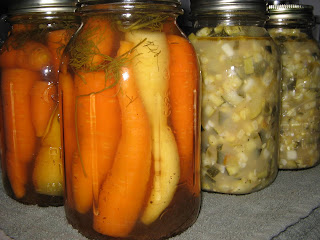
This recipe only makes two 1-pint jars, but we multiplied the recipe to ended up with 8 1-quart jars. We used heaps of yellow pear tomatoes and half lime/half lemon juice. It turned out great and seems like a relatively healthy snack. I could probably eat a whole quart in one sitting… Should be a nice reminder of these long summer days while it’s drizzling outside this winter. I would agree with my mom that canning is not a walk in the park, but it was a lot easier than it seemed and it can be a riot if you have good company on hand.
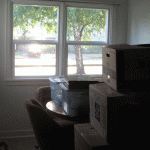
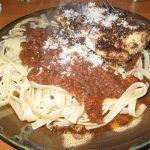

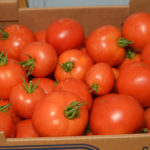
 Spring bed prep, the soil-building way!
Spring bed prep, the soil-building way! 
 Upgrade your hanging basket game!
Upgrade your hanging basket game!  Here’s
Here’s

 This cluster was about the siz
This cluster was about the siz



 I start with a
I start with a
